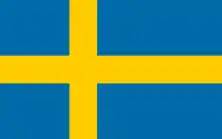İsveç bayrağı
İsveç bayrağı, (İsveççe: Sveriges flagga) mavi bir alan üzerinde sarı veya altın sarısı bir İskandinav haçından oluşur. İskandinav haçı geleneksel Hristiyanlığı temsil eder.[1][2] İsveç bayrağının tasarımının ve renklerinin, mavinin üç ayda bir altın haç ile bölünmüş ve Danimarka bayrağına modellenmiş 1442 İsveç'in mevcut armasından ilham aldığına inanılıyor.[3]
| İsveç | |
|---|---|
 | |
| Ayrıntılar | |
| Kullanan(lar) | İsveç |
| Kabul tarihi | 22 Haziran 1906 |
| Oran | 5:8 |
| Tasarım | Mavi rengin üstünde sarı bir İskandinav haçı. |
Kaynakça
- Jeroen Temperman. State Religion Relationships and Human Rights Law. Martinus Nijhoff Publishers. Erişim tarihi: 31 Aralık 2007.
Many predominantly Christian states show a cross, symbolising Christianity, on their national flag. Scandinavian crosses or Nordic crosses on the flags of the Nordic countries–Denmark, Finland, Iceland, Norway and Sweden–also represent Christianity.
- Carol A. Foley. The Australian Flag: Colonial Relic or Contemporary Icon. William Gaunt & Sons. Erişim tarihi: 31 Aralık 2007.
The Christian cross, for instance, is one of the oldest and most widely used symbols in the world, and many European countries, such as the United Kingdom, Norway, Sweden, Finland, Denmark, Iceland, Greece and Switzerland, adopted and currently retain the Christian cross on their national flags.
- Andrew Evans. Iceland. Bradt. Erişim tarihi: 31 Aralık 2007.
Legend states that a red cloth with the white cross simply fell from the sky in the middle of the 13th-century Battle of Valdemar, after which the Danes were victorious. As a badge of divine right, Denmark flew its cross in the other Scandinavian countries it ruled and as each nation gained independence, they incorporated the Christian symbol.
This article is issued from Wikipedia. The text is licensed under Creative Commons - Attribution - Sharealike. Additional terms may apply for the media files.